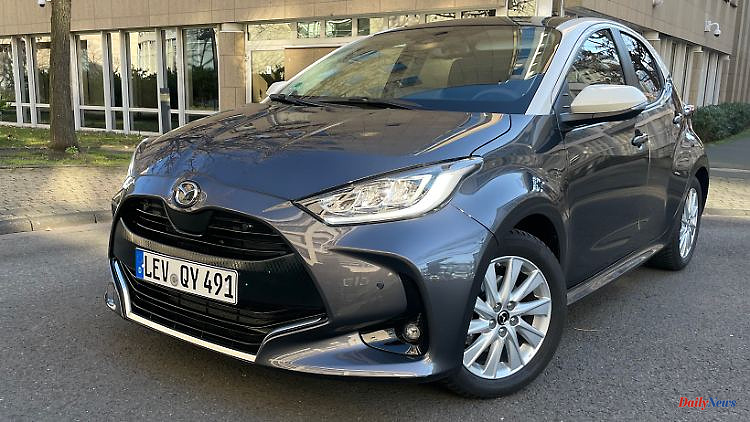Full hybrids without an external option to recharge the battery have gone out of fashion, but they have by no means disappeared. Mazda even offers the small car with the model designation "2" as a double engine. It's a loan from Toyota, but that doesn't matter.
Before we go on tour with the Mazda 2 Hybrid, a few things need to be clarified. First: This Mazda is a Toyota. I'm sorry, what? Yes, because the Mazda 2 actually looks very different. But because the team from Hiroshima would also like to offer a hybrid variant in the small car segment and the existing model cannot even be technically overhauled, they apparently called Nagoya and asked if they could buy a contingent of Yaris Hybrids. It was allowed and the result is the Mazda 2 Hybrid, which not only looks exactly like the Yaris, but even has the same internal model designation (XP21). Mazda has experience with such "badge" deals and around three decades ago already offered the "121" model, which was basically just a Fiesta.
Second: The Mazda 2 Hybrid is really a small car. During Volkswagen Polo
The supposed disadvantage is that the second row is a bit narrower. But is that a disadvantage? Usually not really, because hardly any small car should be used for long journeys with a full crew. And if you do - you don't even sit really badly in the back. Naturally, the knee room is limited, but the seating furniture seems quite decent. Always in the back of your mind: the small car standard.
It's amazing that two engines fit under so little sheet metal. After all, the combustion engine is a compact three-cylinder, but it still has a displacement of 1.5 liters and offers 92 hp. And the 80 hp of the electric motor are a reliable indicator that you are dealing with a full hybrid - the electric motor can therefore also drive the Mazda on its own. However, significant distances without a combustion engine can hardly be covered, because the battery, which has a capacity of only 0.8 kilowatt hours, cannot be charged externally.
But enough power to sneak the last 500 meters through the nocturnal housing estate with a careful use of the right pedal, for example. That way, at least, the neighborhood won't be bothered if you come home late at night. With a system output of 116 hp, the 1.1-ton truck certainly doesn't become a dynamic riot gun, but an unloving start is different. And because with the whole vehicle the entire so-called power-split drive is of course borrowed from Toyota, the petrol engine develops a robust three-cylinder timbre with courageous use (in this constellation the petrol engine is a three-cylinder), but not at all annoying, but refreshing sounds lively.
On this occasion, a short digression into the technical conventions should not be missing. Because the extremely smooth action of the machine ensemble is due to the fact that no friction clutches are involved. A planetary gearbox, in which both the petrol engine and the electric motor are combined, serves as the torque split. The translation can then also be changed via the regenerative braking activity. And: Since they are both integrated into the planetary gear set (which is a hodgepodge of gears that roll on an outer gear rim), petrol engines and electric machines can drive flexibly - or the battery is charged by the combustion engine, depending on the operating mode.
With this technical knowledge in mind, the Mazda 2 is even a little bit more fun, at least for the tech fans. And those who have little to do with technology will at least be happy about the soft-looking drive technology, which ultimately also pays into the comfort account. Well, the truth is of course also that the small car acts appropriately for its segment.
Of course, it gets a little louder on the Autobahn at recommended speed and doesn't parry bumps quite as smoothly as a large sedan might. However, the Japanese does a good job on occasional weekend trips, even to distant destinations, and is an all-rounder. In such a case, the rental car company would probably get nothing.
Especially since the interior designers apparently worked well with the infotainment specialists. Plenty of display space, including a touchscreen that is strategically well placed in terms of operation and visibility, should make the inclined, young clientele happy. Things are happening on the monitor, such as smartphone integration (Apple CarPlay or Android Auto) plus the operation of many vehicle functions.
It is nice and by no means a matter of course in this class that the head-up display available as an option ("Select" equipment line) actually projects its information directly onto the windshield and not onto a cheap-looking Plexiglas pane in front of it. In addition, the instrument cluster of the Mazda 2 is good proof that architectural sophistication can definitely be combined with the demand for modern infotainment. A visually charming clustered instrument unit, thanks to three independent displays, fulfills its task of providing the driver with various data such as on-board computer values or simply the speed in the best possible way.
Any questions? The Mazda 2 Hybrid, which costs at least 23,190 euros, is not exactly a real bargain, although the equipment with autonomous emergency braking, Bluetooth hands-free system, automatic air conditioning, smartphone integration, lane departure warning, traffic sign recognition and adaptive cruise control turns out to be quite decent. The distance to the most expensive "Select" line is at least 6000 euros. Then, however, not only the head-up display is on board, but also goodies such as aluminum wheels, LED headlights, parking beepers and the chic and sporty seats. Things like steering wheel heating, reversing camera, keyless locking system and heated seats are already included here, because they are part of the "Agile" line (2800 euros extra to the base).
Conclusion: Does hybrid make sense in a small car? You might think so, because no matter how complex the system with two engines may be, a glance at the scales shows that hybrids do not have to overflow in terms of resources. A battery-electric car in a similar formation would easily be 300 to 400 kilograms heavier than the hybrid, which weighs exactly 1105 kilograms. With a consumption of four liters per 100 kilometers in the average WLTP discipline, this Mazda is ambitious, although in practice it sometimes indulges in four and a half liters with higher motorway shares (which is still okay). In terms of price, however, hybrid is more of a luxury, because the manufacturer charges for the complex technology. Incidentally, the Mazda 2 with a pure combustion engine starts at a comparatively low 15,590 euros, but with just as low 75 hp.












